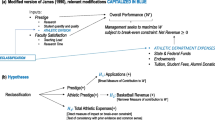Abstract
What are the factors that cause members of the National Collegiate Athletic Association (NCAA) intercollegiate sports cartel to cheat? We develop a model that reflects the multi-institutional aspects of the decision process involved in the determination of major football program NCAA violations including university performance and incentives, rival behavior, and NCAA enforcement. Prior research is prone to omitted variable bias since studies have typically focused on only one of those components. The data sample includes all major football programs from 1981 to 2011, with 3,420 annual institution observations. Our empirical results confirm the multidimensional aspects of the cheating calculus. University characteristics and leadership, conference rivals, public/private university status, and different NCAA enforcement regimes are all significant contributors to the decision to cheat on the NCAA cartel.
Similar content being viewed by others
Notes
See NCAA v. Board of Regents of University of Oklahoma, 468 U.S. 85 (1984).
References
Anderson, M. L. (2012). The benefits of athletic success: an application of the propensity score design with instrumental variables. Cambridge: National Bureau of Economic Research Working Paper Series, (Working Paper 18196).
Baade, R. A., & Sundberg, J. (1994). Fourth down and gold to go? Assessing the link between athletics and alumni giving. Social Science Quarterly, 77(4), 789–803.
Barro, Robert. (2002). The best little monopoly in America. BusinessWeek, December 9, 22.
Bennett, R. W., & Fizel, J. (1995). Telecast deregulation and competitive balance. American Journal of Economics and Sociology, 54(2), 183–200.
Brady, Erik, Steve Berkowitz, and Jodi Upton. (2012). College football coaches continue to see salary explosion. USA Today, November 20, at http://www.usatoday.com.
Byers, W. (1995). Unsportsmanlike conduct: exploiting college athletes. Ann Arbor: University of Michigan Press.
Clark, R. S., & Batista, P. J. (2009). Do BCS national championships lead to recruiting violations? A trend analysis of NCAA division I (FBS) infractions. Journal of Sports Administration and Supervision, 1(1), 8–22.
CNN/SI. (2013a). 1997 College Football Bowl Payouts, at http://sportsillustrated.cnn.com.
CNN/SI. (2013b). 1998 College Football Bowl Payouts, at http://quicktime.cnnsi.com.
CollegeFootballPoll. (2013). 2012–2013 College Football Season Bowl Results at, http://www.collegefootballpoll.com/2012_archive_bowls.html.
Eckard, E. W. (1998). The NCAA cartel and competitive balance in college football. Review of Industrial Organization, 13(3), 347–369.
Fleisher, A. A., III, Shugart, W. F., Tollison, R. D., & Goff, B. L. (1988). Crime or punishment? Enforcement of the NCAA football cartel. Journal of Economic Behavior & Organization, 10(4), 433–451.
Fleisher, A. A., III, Goff, B. L., & Tollison, R. D. (1992). The national collegiate athletic association: a study in cartel behavior. Chicago: University of Chicago Press.
Fort, R., & Winfree, J. (2013). 15 sports myths and why they’re wrong. Stanford: Stanford University Press.
Humphreys, B. R., & Mondello, M. (2007). Intercollegiate athletic success and donations at division I institutions. Journal of Sports Management, 21(2), 265–280.
Humphreys, B. R., & Ruseski, J. E. (2009). Monitoring cartel behavior and stability: evidence from NCAA football. Southern Economic Journal, 75(3), 720–735.
Kahn, L. (2007). Markets: cartel behavior and amateurism in college sports. Journal of Economic Perspectives, 21(1), 209–226.
Lederman, Doug (2011). Half of big-time NCAA programs had major violations. USA Today College, February 7, at http://usatoday30.usatoday.com.
Maxcy, J. G. (2004). The 1997 restructuring of the NCAA: a transactions cost explanation. In J. Fizel & R. Fort (Eds.), Economics of college sports (pp. 11–34). Westport: Praeger.
NCAA. (1994). NCAA News. January 12, at http://fs.ncaa.org/Docs/NCAANewsArchive/1994/19940112.pdf.
NCAA. (2012). Financial Review of 2011–2012 Post Season Bowls. May 24, at http://www.ncaa.org/sites/default/files/2011-12%2BPostseason%2BFootball%2BFinancial%2BReporting%2B(2).pdf.
NCAA. (2013). Chronology of enforcement, January 21, at http://www.ncaa.org/wps/wcm/connect/public/NCAA/Enforcement/Resources/Chronology+of+Enforcement.
Noll, R. G. (1991). The economics of intercollegiate sports. In J. Andre & D. N. James (Eds.), Rethinking college athletics (pp. 197–209). Philadelphia: Temple University Press.
Otto, K. A. (2005). Major violations and NCAA ‘Powerhouse’ football programs: what are the odds of being charged? Journal of Legal Aspects of Sport, 15(1), 39–57.
Rishe, P. J. (2003). A reexamination of how athletic success impacts graduation rates: comparing student-athletes to all other undergraduates. The American Journal of Economics and Sociology, 62(2), 407–427.
Toma, J. D., & Cross, M. E. (1996). Intercollegiate athletics and student college choice: understanding the impact of championship seasons on the quantity and quality of undergraduate applicants. Las Vegas: ASHE Annual Meeting Paper.
Toma, J. D., & Cross, M. E. (1998). Intercollegiate athletics and student college choice. Research in Higher Education, 39(6), 633–661.
Tucker, I. B. (1992). The impact of big-time athletics on graduation rates. Atlantic Economic Journal, 20(4), 65–72.
Tucker, I. B. (2004). A reexamination of the effect of big-time football and basketball success on graduation rates and alumni giving rates. Economics of Education Review, 23(6), 655–661.
Tucker, I. B. (2005). Big-time pigskin success: is there an advertising effect? Journal of Sports Economics, 6(2), 222–229.
Author information
Authors and Affiliations
Corresponding author
Rights and permissions
About this article
Cite this article
Fizel, J., Brown, C.A. Assessing the Determinants of NCAA Football Violations. Atl Econ J 42, 277–290 (2014). https://doi.org/10.1007/s11293-014-9417-3
Published:
Issue Date:
DOI: https://doi.org/10.1007/s11293-014-9417-3




